Alfredo Barbini Murano Confetti Hand Blown Glass Chandelier
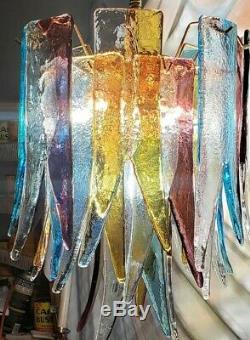
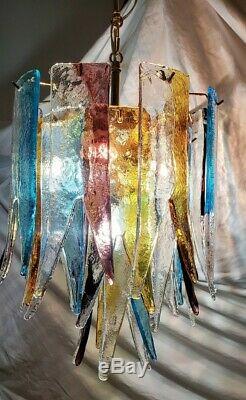
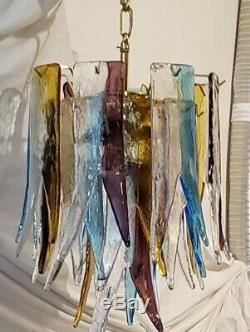
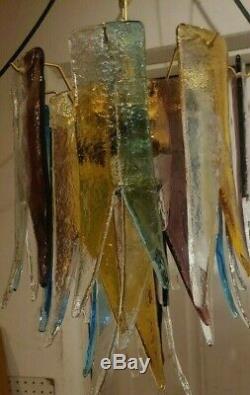
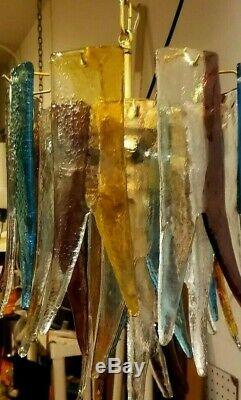
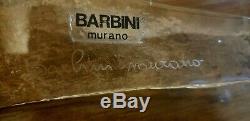
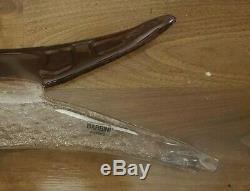
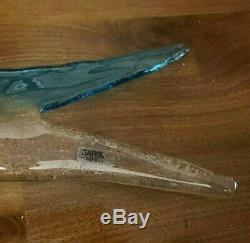

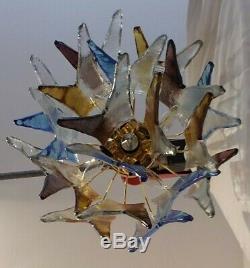
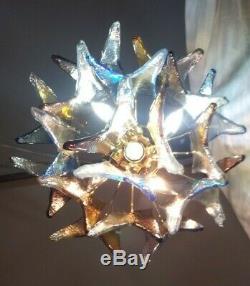

I probably don't need to say anything more than Barbini but just as a refresher (for me as well as you) here's some info on this amazing Glass Craftsman. Alfredo Barbini was a glass artist born in 1912 on the island of Murano in the lagoon of Venice Italy. He was one of Muranos leading. Figures of the twentieth century.
His parents were members of families which had been prominent in the glassmaking industry on Murano for generations. Alfredo Barbini began his long career in 1925 at the age of 13, working in the S. In 1929 he joined Cristalleria di Venezia e Murano as a.
Zecchin & Martinuzzi firm and then with Seguso Vetri d'Arte. From 1936 to 1944 he was a partner and master glassblower at Societa Anonima. Vetri Artistici Murano, known as S.
Following WW II Barbini worked as master glassblower and designer successively with Archimede Seguso and Napoleone Martinuzzi, then became a partner. With Vetreria Vistosi and, later, with Gino Cenedese. With financial assistance from the firm of Salviati & Co.
For whom he produced products, he formed, in 1950 his own glass firm, Vetreria Alfredo Barbini which was. Reorganized in 1983 as Alfredo Barbini Srl. His firm exhibited his work at the Venice Biennales from 1950 to 1961. Among numerous other honors , Barbini was awarded the "Osella d'Oro" by Venice's Associazione degli Industriale and the honorary title "Commendatore". In 1989 he was named "1989 Venetian of the Year" by the Settimare Association.
THE GREAT MURANO GLASS MASTERS: ALFREDO BARBINI. Muranos history is made by hundreds of talented and ingenious glass masters. Many of them attained prominence centuries ago, while others are still stunning the world with dazzling creations.
Others have collaborated together to evolve the glass-making industry and bring it global fame, which it is still enjoying today. Each and every one of them, however, has contributed invaluably to Muranos history and beauty, surprising admirers and collectors with new ideas, artistic boldness, and alluring designs. Such is the case of the Barbini family, who has been an important presence in Muranos history since ages ago, and is still present in todays picture. The Barbini family goes back a long way. Their story in the Murano Glass industry can be traced back to the XVI century, when the family name was added to Venices Golden Book, a book known for containing the crème de la crème of Venetian noble families and the best glass masters, whose guild received special permission to be in the Book.Members of the Barbini family played active roles in Venices history for a long time, be it in politics, commerce, or different areas of glass production. Many of them became famous thanks to their beautiful Venetian mirrors, others thanks to their enamel glass, others still for making majestic chandeliers. Some members of the Barbini family even moved to abroad in order to create decorative glass exclusively for royal houses and the wealthiest foreign families. During the following centuries the Barbini family started counseling other glass masters, such as Pietro Bigaglia, the Briati family, the Bertolini brothers and Benetto Barbaria. All of them in turn went on to make significant contributions to Muranos glass-blowing innovations and history.
Alfredo Barbinis story, however, starts many centuries later. Born in 1912 in Murano, he quickly became known as a very skillful glass master. Beginning his career with one of Muranos most famous furnaces, Alfredo started working at Ferro Tosos factory at the tender age of 13.
After 17 years of working for Toso, he left the furnace and joined the Cristalleria di Venezia e Murano to become its principal master glassblower. During that time, he showed an incredibletalent in designing and crafting bold and beautiful glass pieces. In 1932, he joined Zecchin & Martinuzzi, a furnace that allowed his creativity to blossom and where he created his most impressive designs over the next three years. This last furnace provided him with more artistic liberties than the previous ones, that focused much more on the technical aspects of glass craftsmanship.
Unfortunately, Zecchin & Martinuzzi eventually closed, and Barbini moved on to work for Seguso Vetri dArte for a short period, ending up later on at Vetreria Artistica Muranese Società Anonima until 1944. After World War II Barbini went back to working with Seguso and Martinuzzi independently, gaining more and more recognition as the famous master glassblower and designer. His strong aesthetics and vivid imagination allowed him to mold his designs to satisfy the preferences of his colleagues and patrons with no problem at all. His experience expanded even more after working for two other great masters, Luigi Scarpa Croce and Salviati.By 1946, he had become artistic director and business associate of Gino Cenedese & C. During this time he broadened his mastery in glass sculptures and different chromatic effects such as the vetro fumato or smoky glass. In 1948, during Venices Biennale and under Cenedese company name, he presented an incredible collection of decorative art glass in corroso style mimicking corroded surface effects.
In 1950 with Salviatis economic help, Alfredo Barbini managed to open his own firm, Vetreria Alfredo Barbini. From this year on and until 1961, Barbini was an important presence in many Venice Biennale art exhibitions. His interest turned to ore essential and minimal forms, such as the instantly-famous fish and tulip artworks he submitted for the Venice Biennale in 1960. In later years, his works were also characterized by a series of small and fine incisions engraved on the surface of each glass object, decorating the surface of delicate vases and other art glass pieces. One of the techniques he perfected and specialized in throughout the years was the Massello technique. This technique is based on stretching hot glass and molding it into a certain shape, allowing the piece to take any form without having to use a glass blowing technique. Another signature style of his was the Sommerso technique. He perfected the way in which thick colored layers of glass were superimposed over each other, fusing each layer so brilliantly that the joining lines seemed non-existent; they were seamlessly turning into each other creating brilliant reflections and amazing color combinations. Another one of his favorite techniques was the Corrosione, in which the outer layer of the glass object was covered in gold powder or any other metal, and obtained corroded appearance once it came in contact with heat. Every single piece made by Alfredo Barbini himself is recognizable thanks to the A. Barbini signature impressed on it, while works made by his workshop are signed as only Barbini.If Barbinis artworks were admired, his workshop was worthy of the same admiration. Constructed during the mid 1960s, Barbinis furnace itself was a piece of art resembling a gothic cathedral more than a glass factory, lit through stained glass windows contrasting strong colors with light reflections. In time Alfredo introduced his son Flavio and his daughter Oceania to the art of glass-making, leaving his whole legacy to them. Barbini died on February 13th 2007, leaving Murano and the whole world a rich heritage of knowledge and mastery in glass making and helping turn an old craft into modern art. Now, as to this beautiful piece.
I've owned it and its been hanging in my home since the 90's. It is signed by Barbini twice. (Two of the glass pieces are labeled and SIGNED). There are 20 pieces of thick beautiful hand blown glass. Nineteen pieces hang on the fixture and there is one which came with the chandelier as an extra in case one ever breaks. You would have to take a hammer to it to break one. Each piece is about 1/2 inch thick. This piece was made in Murano, Italy circa 1980. It is 22 high (not including the chain) with a diameter of 15 inches and is in very good condition. This beautiful chandelier would look marvelous in your gorgeous home. All pictures are of the actual item and were recently taken by me.The item "ALFREDO BARBINI MURANO CONFETTI HAND BLOWN GLASS CHANDELIER" is in sale since Friday, April 24, 2020. This item is in the category "Pottery & Glass\Glass\Art Glass\Italian". The seller is "richieess" and is located in Fort Lauderdale, Florida. This item can be shipped to United States, United Kingdom, Denmark, Romania, Slovakia, Bulgaria, Czech republic, Finland, Hungary, Latvia, Lithuania, Malta, Estonia, Australia, Greece, Portugal, Cyprus, Slovenia, Japan, China, Sweden, South Korea, Indonesia, Thailand, Belgium, France, Hong Kong, Ireland, Netherlands, Poland, Spain, Italy, Germany, Austria, Bahamas, Israel, Mexico, New Zealand, Singapore, Switzerland, Norway, Saudi arabia, United arab emirates, Qatar, Bahrain, Croatia, Malaysia, Chile, Panama, Jamaica, Bangladesh, Brunei darussalam, Bolivia, Egypt, French guiana, Guernsey, Gibraltar, Guadeloupe, Iceland, Jersey, Jordan, Cambodia, Liechtenstein, Luxembourg, Monaco, Macao, Martinique, Nicaragua, Pakistan, Paraguay, Uruguay, South africa, Colombia, Barbados, Bermuda, Cayman islands, Sri lanka, Maldives, Oman, Reunion.
- Color: Multi-Color
- Glassmaking Technique: Hand Blown
- Type of Glass: Hand Blown Glass
- Brand: Barbini
- Original/Reproduction: Vintage Original
- City of Origin: Murano
- Features: Signed
- Object Type: Chandelier

